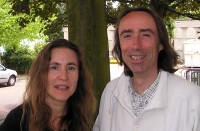Using a multidisciplinary approach, we investigate the metabolism and stress responses of cyanobacteria (the most abundant photosynthetic organisms) with the prospect of using them for the sustainable production of biofuels, and biodetection of metal pollutants. These two objectives are intrinsically related as the metabolism uses a wealth of metallo-enzymes.

Team Leaders |
Human resources
Franck Chauvat, Researcher - Corinne Cassier-Chauvat, Researcher
Sandrine Farci, Technician - Théo Veaudor, PhD Student
Cyanobacteria
Cyanobacteria, the only known prokaryotes that perform
oxygen-evolving photosynthesis, are environmentally crucial organisms, which logically receive a strong attention in basic and applied researches. Cyanobacteria, which are the most abundant photosynthetic organisms on Earth, use solar energy, water, CO2 and mineral salts to produce a large part of the oxygen and biomass for the food chain.
In nature, cyanobacteria are inevitably challenged by toxic reactive oxygen species generated by their metal-rich photosynthesis under intense illumination, i.e. when the production of photosynthetic electrons exceeds what needed for the assimilation of inorganic substrates. Furthermore, in requiring high amounts of various metals (iron, zinc, Cu, Mn etc) for growth, cyanobacteria are also frequently affected by changes in metal availability and/or the presence of heavy metals, which are increasingly spread in environment through human industries and agriculture, and constitute persistent pollutants because they cannot be degraded. Consequently, it is important to analyze the protection against oxidative and metal stresses in cyanobacteria because they constitute the first biological barrier against the entry of toxics into the food chain, and these crucial organisms have developed most of the stress-tolerance mechanisms, a large number of which have been evolutionary conserved.
Furthermore, the increasing concerns related to energy availability and independence, and the negative environmental impact of using fossil fuels (pollution and climate change) make it important to develop renewable and environmentally-friendly energy sources. Cyanobacteria, the most abundant photosynthetic organisms on Earth, have the potentials for the production of renewable biofuels from nature's most plentiful resources, solar light, water, mineral salts and the greenhouse gas CO2, while saving arable soils, fertilizers, pesticides and fresh waters for crops production. Indeed, cyanobacteria perform a powerful oxygen-producing photosynthesis; they are robust (they have colonized most waters and soils of our planet); and some strains have a powerful genetics. Their genetics is welcome as natural cyanobacteria are not suitable bio-fuel producers because some of the required metabolic pathways are lacking or need optimization.
Thanks to our
long-standing expertise in cyanobacteria we use a "synthetic biology" approach to reprogram a few model cyanobacteria for the photo-production of ethanol, hydrogen and terpenes (the energy-dense compounds that can be blended with petroleum-based fuels to turn them into kerosene for aviation, i.e. jet-fuel).
Contact :
Franck Chauvat
In addition, we investigate the responses of cyanobacteria to the inter-twinned oxidative and metal stresses, which often limits the production of cyanobacterial biomass or high-value products (bio-fuels, vitamins, polysaccharides, etc).
Contact :
Corinne Cassier-Chauvat
Cyclope Conference of CEA Saclay - Cyanobactéries : Des origines de la vie à la conquête de l'espace
Soil remediation, production of energy, fertilization, food, drug manufacturing... those that are also called "blue algae" could become an ally not to be neglected.
On the occasion of a conference in October 2013, Franck and Corinne Chauvat, who study
everyday these amazing microorganisms, proposed for the general public to have a look in their microscope (in french).